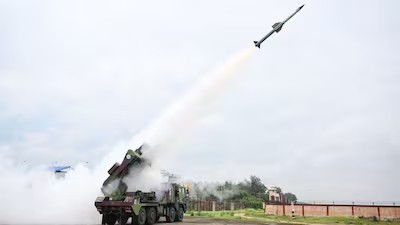India’s Integrated Air Defence Weapon System (IADWS) Test: A New Era in Multi-Layered Security
- MGMMTeam

- Aug 25
- 4 min read
On August 23, 2025, India took a giant stride in strengthening its aerial security with the successful maiden test of the Integrated Air Defence Weapon System (IADWS). Conducted by the Defence Research and Development Organisation (DRDO) off the coast of Odisha at around 12:30 p.m., the exercise marked a milestone in India’s defence technology journey. For the first time, a multi-layered defence system, fully designed and developed indigenously, proved its ability to neutralise multiple aerial threats simultaneously.
The trial was observed from the Integrated Test Range in Chandipur and confirmed by independent monitoring instruments. It showcased not only India’s growing technological might but also its commitment to building a robust self-reliant defence architecture under the Aatmanirbhar Bharat initiative.

Anatomy of the IADWS
The IADWS is built on three powerful components that work in perfect synchronization. The first is the Quick Reaction Surface-to-Air Missile (QRSAM), a highly mobile system designed to counter fast-moving aircraft and cruise missiles within a range of 30 kilometres. Its radar can detect and track multiple targets on the move, providing the flexibility needed for battlefield conditions.
Complementing this is the Very Short Range Air Defence System (VSHORADS). Lightweight and portable, it protects troops and installations from low-flying drones, helicopters, and aircraft within a six-kilometre range. Its infrared guidance makes it especially effective in short-range scenarios where threats emerge suddenly.
The third and most futuristic component is the Directed Energy Weapon (DEW), a high-power laser system capable of disabling drones and unmanned aerial vehicles within a few kilometres. Unlike missiles, the DEW relies on precision energy beams, offering a silent, cost-effective, and rapid-response solution to the growing challenge of drone swarms.
These three layers are united under a centralised Command and Control Centre, which coordinates radars, communication networks, and target allocation to ensure a seamless and integrated response.
Precision in Action
The maiden trial was not merely a symbolic demonstration but a carefully orchestrated live exercise. Three types of aerial targets—a pair of fast unmanned aerial vehicles and a multi-copter drone—were launched simultaneously to test the system’s coordination and responsiveness.
The QRSAM successfully destroyed a high-speed target at longer range, the VSHORADS intercepted another threat at close range, and the DEW neutralised the drone with silent precision. Each interception was carried out flawlessly, proving that the system could handle multiple and diverse aerial threats at once. This real-time coordination validated India’s claim to having developed a true multi-layered shield for the skies.
Strategic Importance and Mission Sudarshan Chakra
The Defence Minister, Rajnath Singh, hailed the success as a transformative leap, affirming that the IADWS “established the multi-layered air-defence capability of our country.” He emphasised its role in safeguarding vital national assets, from military bases to strategic infrastructure.
Beyond the immediate achievement, the IADWS is part of the larger vision of Mission Sudarshan Chakra, announced by Prime Minister Modi on Independence Day 2025. This mission seeks to build a nationwide, indigenously produced, and technologically advanced aerial shield by 2035. The IADWS will form a central pillar of this initiative, eventually integrating with other systems such as Akash, Barak, and the long-range Project Kusha.
Global Attention and Expert Views
India’s introduction of a laser-based directed energy weapon has attracted global attention. International observers, including Chinese aerospace experts, have acknowledged the significance of this development, noting that only a handful of countries like the United States, Russia, China, and Israel have made comparable progress. However, some analysts cautioned that real combat conditions, unlike controlled test ranges, would be the ultimate test of the system’s effectiveness.
Nevertheless, the maiden test has undeniably positioned India within a select league of nations working on advanced, futuristic defence technologies.
Towards a Self-Reliant Future
The successful demonstration of IADWS highlights India’s growing confidence in defence self-reliance. By replacing dependence on imported systems with indigenous solutions, India not only strengthens its strategic autonomy but also sets the stage for defence exports in the future.
The integration of AI-driven battle management systems, like the Indian Army’s Akashteer network, with IADWS promises an even more secure and connected defence grid. As aerial threats evolve—ranging from drones to hypersonic missiles—India’s layered defence approach will serve as a decisive shield for its security architecture.
Conclusion
The maiden test of the Integrated Air Defence Weapon System is more than a technological feat; it is a declaration of India’s readiness to defend its skies with indigenous strength. With its blend of missiles, laser systems, and advanced command networks, the IADWS symbolises a forward-looking approach to modern warfare. As part of Mission Sudarshan Chakra, it will play a central role in creating a comprehensive, layered defence shield that secures India’s sovereignty in the decades ahead.
By combining innovation, precision, and vision, India has taken a bold step towards building an unbreakable wall of security in the air—heralding a new era of defence self-reliance.
(Sources: News18, Firstpost, Times of India)




Comments